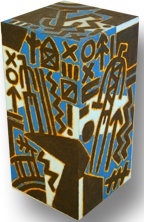

✕
Ferenc Gögös
Name:
CUBE
Year:
1989
Size:
80 x 40 x 40 cm
Technique:
oil on board (cube)
Extra information:
unique piece
Ferenc Gögös (Budapest ’36) came to the Netherlands in 1957, when his freedom was threatened in his homeland. He enrolled at the Academy of Arts in Arnhem to study painting and graphic arts. His works are composed of signs, messages that communicate their meaning. The image replaces language. If one emerges oneself into the works, one discovers several recognizable images, like a man, a woman, a deer, a bird or a tree.
Other signs only make sense in combination with the surrounding images. Darts, zigzags, edges, and straight lines connect these symbols. Ferenc Gögös symbols relate to popular arts or “primitive” arts which gives them a universal character. His Hungarian origins can be sensed especially in the early works. Tingling color planes comprising monumental signs are witness to a great sensibility for materials and colors.
Gogos has exhibited frequently in both the Netherlands as well as foreign countries, amongst others in Arnhem, Amsterdam, Nijmegen, Ghent, Budapest, Nishinomya and Kyoto (Japan), South-Korea, California and Ohio (U.S.A.) and at the art fair in Basle.
Gögös works are included in numerous art collections in, amongst others, the Netherlands, Belgium, Japan, Germany, the USA, Hungary and Australia.
Ferenc Gogos work in museums: amongst others, Stedelijk Museum Amsterdam, Gemeente Museum Arnhem, Commanderie St. Jan Nijmegen, the Museum of Fine Arts as well as the National Museum Budapest.
For more works of Ferenc Gögös also see